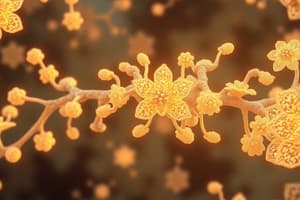Podcast
Questions and Answers
Which type of immunity is the focus of Defense Against the Dark Arts (Immunology)?
Which type of immunity is the focus of Defense Against the Dark Arts (Immunology)?
- Adaptive Immunity
- Cellular Immunity
- Passive Immunity
- Innate Immunity (correct)
What is the primary function of the physical barriers in the first line of defense?
What is the primary function of the physical barriers in the first line of defense?
- Producing antibodies
- Directly destroying pathogens
- Activating complement components
- Preventing pathogenic microbe colonization (correct)
Which component plays a key role in the first line of defense by providing immediate protection?
Which component plays a key role in the first line of defense by providing immediate protection?
- Microbiota
- C3 convertase
- Chemical barriers (correct)
- Complement components
What is the main function of C3a and C5a during complement activation?
What is the main function of C3a and C5a during complement activation?
What can excessive C3a and C5a induce?
What can excessive C3a and C5a induce?
Which granule contents are released due to the degranulation promoted by C3a and C5a?
Which granule contents are released due to the degranulation promoted by C3a and C5a?
What is the consequence of smooth muscle contraction induced by granule contents?
What is the consequence of smooth muscle contraction induced by granule contents?
Which protein enhances the activity of C3bBb by stabilizing the complex and preventing its degradation by proteases?
Which protein enhances the activity of C3bBb by stabilizing the complex and preventing its degradation by proteases?
What is the result of Factor I deficiency in complement activation?
What is the result of Factor I deficiency in complement activation?
Which complement receptor binds to C3b and activates the phagocytic process?
Which complement receptor binds to C3b and activates the phagocytic process?
What happens when CR1 ligation with C3b occurs on the macrophage surface?
What happens when CR1 ligation with C3b occurs on the macrophage surface?
What is the function of a phagosome in the immune response?
What is the function of a phagosome in the immune response?
Which complement component cleaves C5 into C5a and C5b?
Which complement component cleaves C5 into C5a and C5b?
What is the function of C5b in complement activation?
What is the function of C5b in complement activation?
Which factor prevents the recruitment of complement components to the cell membrane?
Which factor prevents the recruitment of complement components to the cell membrane?
'Paroxysmal nocturnal hemoglobinuria' is characterized by complement-mediated lysis of which cells?
'Paroxysmal nocturnal hemoglobinuria' is characterized by complement-mediated lysis of which cells?
What does Factor H do in complement activation?
What does Factor H do in complement activation?
What is the role of Factor I in complement activation?
What is the role of Factor I in complement activation?
Which factor prevents complement-mediated damage by blocking complement activity in human cells?
Which factor prevents complement-mediated damage by blocking complement activity in human cells?
Which enzyme hydrolyzes bacterial cell walls?
Which enzyme hydrolyzes bacterial cell walls?
What are the substances that disrupt microbial metabolism and sequester iron?
What are the substances that disrupt microbial metabolism and sequester iron?
What is the role of commensal microorganisms in the human body?
What is the role of commensal microorganisms in the human body?
Where is the largest population of commensal microorganisms found?
Where is the largest population of commensal microorganisms found?
What percentage of immune cells reside in the gut epithelium?
What percentage of immune cells reside in the gut epithelium?
What activates the complement system when a pathogen penetrates the epithelial barrier?
What activates the complement system when a pathogen penetrates the epithelial barrier?
What is essential for the production of C3 convertase in the alternate pathway of complement activation?
What is essential for the production of C3 convertase in the alternate pathway of complement activation?
What plays a role in complement-mediated lysis of microorganisms?
What plays a role in complement-mediated lysis of microorganisms?
What is produced when C3 undergoes a spontaneous conformation change or is cleaved by Factor D?
What is produced when C3 undergoes a spontaneous conformation change or is cleaved by Factor D?
What are cyclic proteins that bind to pathogens, facilitating phagocytosis?
What are cyclic proteins that bind to pathogens, facilitating phagocytosis?
What are antimicrobial peptides that destroy microbial membranes?
What are antimicrobial peptides that destroy microbial membranes?
What is the primary function of the physical barriers in the first line of defense?
What is the primary function of the physical barriers in the first line of defense?
Which complement component cleaves C5 into C5a and C5b?
Which complement component cleaves C5 into C5a and C5b?
What are the substances that disrupt microbial metabolism and sequester iron?
What are the substances that disrupt microbial metabolism and sequester iron?
What plays a role in complement-mediated lysis of microorganisms?
What plays a role in complement-mediated lysis of microorganisms?
What is the role of commensal microorganisms in the human body?
What is the role of commensal microorganisms in the human body?
What is produced when C3 undergoes a spontaneous conformation change or is cleaved by Factor D?
What is produced when C3 undergoes a spontaneous conformation change or is cleaved by Factor D?
Where is the largest population of commensal microorganisms found?
Where is the largest population of commensal microorganisms found?
What is the main function of opsonization in the immune response?
What is the main function of opsonization in the immune response?
What is the role of Factor D in the complement system?
What is the role of Factor D in the complement system?
Which complement protein is produced when C3 undergoes a spontaneous conformation change or is cleaved by Factor D?
Which complement protein is produced when C3 undergoes a spontaneous conformation change or is cleaved by Factor D?
What is the consequence of smooth muscle contraction induced by granule contents?
What is the consequence of smooth muscle contraction induced by granule contents?
What is the function of lactoferrin and transferrin in the immune response?
What is the function of lactoferrin and transferrin in the immune response?
Which factor prevents complement-mediated damage by blocking complement activity in human cells?
Which factor prevents complement-mediated damage by blocking complement activity in human cells?
What is the primary function of the physical barriers in the first line of defense?
What is the primary function of the physical barriers in the first line of defense?
Which complement component stabilizes the C3bBb complex and prevents its degradation by proteases in the alternative pathway of complement activation?
Which complement component stabilizes the C3bBb complex and prevents its degradation by proteases in the alternative pathway of complement activation?
What is the consequence of Factor I deficiency in complement activation?
What is the consequence of Factor I deficiency in complement activation?
What is the primary function of CR1 (complement receptor 1) on macrophages in the immune response?
What is the primary function of CR1 (complement receptor 1) on macrophages in the immune response?
Which complement component initiates the formation of the Membrane Attack Complex (MAC) and directly lyses pathogens by inserting C9 monomers into the pathogen membrane?
Which complement component initiates the formation of the Membrane Attack Complex (MAC) and directly lyses pathogens by inserting C9 monomers into the pathogen membrane?
Which factor prevents the recruitment of complement components to the cell membrane and prevents complement-mediated damage in human cells?
Which factor prevents the recruitment of complement components to the cell membrane and prevents complement-mediated damage in human cells?
What is the main function of C3a and C5a during complement activation?
What is the main function of C3a and C5a during complement activation?
What is the consequence of excessive C3a and C5a?
What is the consequence of excessive C3a and C5a?
Which granule contents are released due to the degranulation promoted by C3a and C5a?
Which granule contents are released due to the degranulation promoted by C3a and C5a?
What is the function of Factor I in complement activation?
What is the function of Factor I in complement activation?
What plays a role in complement-mediated lysis of microorganisms?
What plays a role in complement-mediated lysis of microorganisms?
What is the role of commensal microorganisms in the human body?
What is the role of commensal microorganisms in the human body?
Where is the largest population of commensal microorganisms found?
Where is the largest population of commensal microorganisms found?
Which factor prevents the recruitment of complement components to the cell membrane?
Which factor prevents the recruitment of complement components to the cell membrane?
What is essential for the production of C3 convertase in the alternate pathway of complement activation?
What is essential for the production of C3 convertase in the alternate pathway of complement activation?
Flashcards are hidden until you start studying
Study Notes
-
Physical barriers: Epithelial cells and tight junctions form a physical barrier against environmental microbes. Skin's stratum corneum flakes off, removing adherent microbes. Mucus captures pathogens and is removed by ciliary action, sneezing, coughing, peristalsis, and vomiting.
-
Chemical barriers: Defensins are antimicrobial peptides that destroy microbial membranes. Two types, human alpha and beta defensins, are secreted at mucosal surfaces and by certain cells. Pentraxins are cyclic proteins that bind to pathogens, facilitating phagocytosis. Lysozyme is an enzyme that hydrolyzes bacterial cell walls. Phospholipase A2 and cathelicidins are enzymes that form pores in microbial cell membranes. Lactic and fatty acids, lactoferrin, and transferrin are substances that disrupt microbial metabolism and sequester iron. Hydrochloric acid in the stomach and urea have antibacterial activity.
-
Microbiota as a barrier: Before birth, babies have no commensal microbes. At birth, infants begin to colonize with microorganisms, which develop symbiotic relationships with their hosts. Commensals compete with pathogens for nutrients and space. Higher microbiome diversity is associated with better health.
-
Microbiome changes with development: Up to 80% of immune cells reside in the gut epithelium. The complement system is activated when a pathogen penetrates the epithelial barrier. Complement proteins coat the bacterial surface and enhance phagocytosis. The complement system has multiple functions including microbial lysis, inflammation, and enhanced phagocytosis.
-
Alternate pathway of complement activation: Occurs in the blood and tissues and causes the production of C3 convertase. C3b binds to the pathogen and initiates the complement cascade, leading to the production of C3a and C3b. C3b attached to the pathogen is termed complement fixation.
-
Factors that influence the microbiome: Aging and a reduction in physical activity can lower microbiome diversity. A Westernized diet, high in saturated fats and low in fiber, is thought to reduce microbiome diversity. Increased fiber intake is associated with increased microbiome diversity.
-
Effects of microbiome diversity: Increased microbiome diversity is associated with less inflammation. Aging, a reduction in physical activity, and a Westernized diet can all reduce microbiome diversity.
-
Commensal microorganisms: Commensals have coevolved with placental mammals and have symbiotic relationships with their hosts. The largest population of commensals is found in the large intestine, where oxygen levels are low.
-
Complement system: The complement system is activated when a pathogen penetrates the epithelial barrier and is essential for host defense. The complement system has multiple functions including microbial lysis, inflammation, and enhanced phagocytosis. The complement system is made up of multiple proteins, including C3, which can be activated by different pathways.
-
Complement protein C3: C3 is released from the liver and plays a crucial role in the complement system. C3 can either undergo a spontaneous conformation change or be cleaved to expose its thioester bond, which can then be attacked by water, amino groups, or hydroxyl groups on the pathogen surface. C3b binds to the pathogen, leading to complement fixation and enhanced phagocytosis.
-
Complement system activation: The complement system is activated when a pathogen penetrates the epithelial barrier. Complement proteins coat the bacterial surface and make it easier for phagocytes to engulf and destroy the pathogen.
-
Microbial lysis: The complement system plays a role in the lysis of microorganisms, which is essential for host defense.
-
Inflammation: The complement system plays a role in inflammation, which is essential for host defense and the recruitment of immune cells to the site of infection.
-
Enhanced phagocytosis: The complement system enhances phagocytosis by coating the bacterial surface with complement proteins, making it easier for phagocytes to engulf and destroy the pathogen.
-
Opsonization: The complement system enhances phagocytosis by coating the bacterial surface with complement proteins, a process known as opsonization.
-
Complement protein C3b: C3b is a complement protein that is produced when C3 is activated and binds to the pathogen surface. C3b plays a role in complement fixation and enhanced phagocytosis.
-
C3 convertase: C3 convertase is an enzyme that is produced when C3b binds to the pathogen surface, leading to the production of C3a and C3b.
-
iC3Bb: iC3Bb is a complex of C3b and the complement protein Bb, which plays a role in complement-mediated lysis of microorganisms.
-
Factor D: Factor D is an enzyme that cleaves Factor B to produce Ba and Bb, which is necessary for the production of C3b and C3a.
-
Factor B: Factor B is a complement protein that is cleaved by Factor D, leading to the production of Ba and Bb.
-
Ba and Bb: Ba and Bb are complement proteins that play a role in complement-mediated lysis of microorganisms.
-
C3a and C3b: C3a and C3b are complement proteins that are produced when C3 is activated. C3a is a potent anaphylatoxin and plays a role in the inflammatory response, while C3b plays a role in complement fixation and enhanced phagocytosis.
-
Spontaneous conformation change: C3 can undergo a spontaneous conformation change in the aqueous environment of the blood or tissues, leading to the production of iC3.
-
Thioester bond: The thioester bond of C3 is sequestered in the inactive form, but is exposed when C3 undergoes a spontaneous conformation change or is cleaved by Factor D.
-
Nucleophilic attack: Nucleophilic attack by H2O, R-NH2, or R-OH groups on the pathogen surface can occur when the thioester bond of C3 is exposed.
-
Complement fixation: The binding of C3b to the pathogen surface is referred to as complement fixation.
-
iC3: iC3 is a complement protein that is produced when C3 undergoes a spontaneous conformation change or is cleaved by Factor D.
-
Factor D: Factor D is an enzyme that cleaves Factor B to produce Ba and Bb, which is necessary for the production of C3b and C3a.
-
Ba and Bb: Ba and Bb are complement proteins that play a role in complement-mediated lysis of microorganisms.
-
C3a: C3a is a complement protein that is produced when C3 is activated and plays a role in the inflammatory response.
-
C3b: C3b is a complement protein that is produced when C3 is activated and plays a role in complement fixation and enhanced phagocytosis.
-
C3 convertase: C3 convertase is an enzyme that is produced when C3b binds to the pathogen surface, leading to the production of C3a and C3b.
-
Alternate pathway: The alternate pathway of complement activation occurs in the blood and tissues and causes the production of C3 convertase.
-
iC3: iC3 is a complement protein that is produced when C3 undergoes a spontaneous conformation change in the aqueous environment of the blood or tissues.
-
Ba: Ba is a complement protein that is produced when Factor B is cleaved by Factor D.
-
Bb: Bb is a complement protein that is produced when Factor B is cleaved by Factor D.
-
C3a and C3b: C3a and C3b are complement proteins that are produced when C3 undergoes a spontaneous conformation change or is cleaved by Factor D.
-
Opsonization: The complement system enhances phagocytosis by coating the bacterial surface with complement proteins, a process known as opsonization.
-
Microbial lysis: The complement system plays a role in the lysis of microorganisms, which is essential for host defense.
-
Inflammation: The complement system plays a role in inflammation, which is essential for host defense and the recruitment of immune cells to
-
Alternative pathway of complement activation: C3b binds to pathogen-associated Factor B and promotes cleavage by Factor D.
-
C3bBb is a potent C3 convertase that coats the pathogen surface, while iC3Bb can diffuse away.
-
Properdin (Factor P) enhances the activity of C3bBb by stabilizing the complex and preventing its degradation by proteases.
-
Factor H decreases the number of C3bBb complexes by binding to C3b with Factor I, resulting in cleavage of C3b to iC3b, which cannot form C3 convertase.
-
Factor I deficiency leads to unregulated C3bBb formation, depletion of C3, and increased susceptibility to encapsulated bacteria.
-
Macrophages are the first line of defense against pathogens and express complement receptors, such as CR1, for efficient phagocytosis.
-
CR1 binds to C3b and activates the phagocytic process by promoting the uptake of bound bacteria.
-
CR1 ligation with C3b can disrupt C3 convertase on the macrophage surface and promote the formation of a phagosome.
-
A phagosome fuses with lysosomes, which contain hydrolytic enzymes that destroy the bacterium.
-
Complement activates the next function of complement activation, the alternative C5 convertase (C3b2Bb), which cleaves C5 into C5a and C5b.
-
C5b initiates the formation of the Membrane Attack Complex (MAC), which directly lyse pathogens by inserting C9 monomers into the pathogen membrane, leading to osmotic lysis.
-
Deficiencies in complement components, such as C3, C5-C9, Factor I, and Factor D, increase susceptibility to various infections, particularly those caused by encapsulated bacteria.
-
Factors that block complement activity in human cells, such as CD59, homologous restriction factor (HRF), S protein, clusterin, and Factor J, prevent the recruitment of complement components to the cell membrane and prevent complement-mediated damage.
-
Disruption of the connection between these factors and the plasma membrane can lead to paroxysmal nocturnal hemoglobinuria, a disease characterized by complement-mediated lysis of red blood cells.
Studying That Suits You
Use AI to generate personalized quizzes and flashcards to suit your learning preferences.




